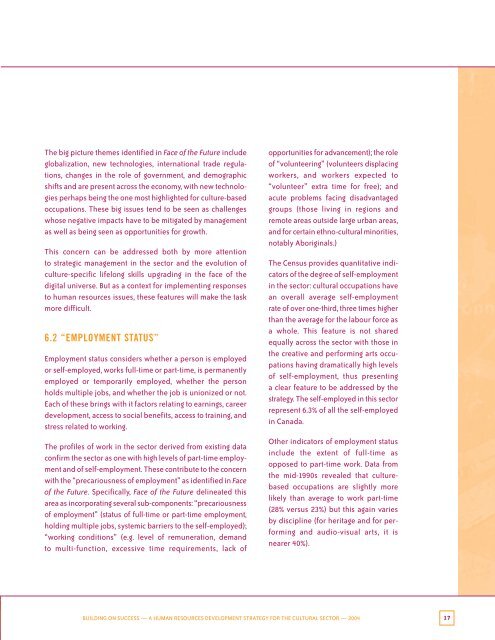Full document
Full document
Full document
You also want an ePaper? Increase the reach of your titles
YUMPU automatically turns print PDFs into web optimized ePapers that Google loves.
The big picture themes identified in Face of the Future include<br />
globalization, new technologies, international trade regulations,<br />
changes in the role of government, and demographic<br />
shifts and are present across the economy, with new technologies<br />
perhaps being the one most highlighted for culture-based<br />
occupations. These big issues tend to be seen as challenges<br />
whose negative impacts have to be mitigated by management<br />
as well as being seen as opportunities for growth.<br />
This concern can be addressed both by more attention<br />
to strategic management in the sector and the evolution of<br />
culture-specific lifelong skills upgrading in the face of the<br />
digital universe. But as a context for implementing responses<br />
to human resources issues, these features will make the task<br />
more difficult.<br />
6.2 “EMPLOYMENT STATUS”<br />
Employment status considers whether a person is employed<br />
or self-employed, works full-time or part-time, is permanently<br />
employed or temporarily employed, whether the person<br />
holds multiple jobs, and whether the job is unionized or not.<br />
Each of these brings with it factors relating to earnings, career<br />
development, access to social benefits, access to training, and<br />
stress related to working.<br />
The profiles of work in the sector derived from existing data<br />
confirm the sector as one with high levels of part-time employment<br />
and of self-employment. These contribute to the concern<br />
with the “precariousness of employment” as identified in Face<br />
of the Future. Specifically, Face of the Future delineated this<br />
area as incorporating several sub-components: “precariousness<br />
of employment” (status of full-time or part-time employment,<br />
holding multiple jobs, systemic barriers to the self-employed);<br />
“working conditions” (e.g. level of remuneration, demand<br />
to multi-function, excessive time requirements, lack of<br />
opportunities for advancement); the role<br />
of “volunteering” (volunteers displacing<br />
workers, and workers expected to<br />
“volunteer” extra time for free); and<br />
acute problems facing disadvantaged<br />
groups (those living in regions and<br />
remote areas outside large urban areas,<br />
and for certain ethno-cultural minorities,<br />
notably Aboriginals.)<br />
The Census provides quantitative indicators<br />
of the degree of self-employment<br />
in the sector: cultural occupations have<br />
an overall average self-employment<br />
rate of over one-third, three times higher<br />
than the average for the labour force as<br />
a whole. This feature is not shared<br />
equally across the sector with those in<br />
the creative and performing arts occupations<br />
having dramatically high levels<br />
of self-employment, thus presenting<br />
a clear feature to be addressed by the<br />
strategy. The self-employed in this sector<br />
represent 6.3% of all the self-employed<br />
in Canada.<br />
Other indicators of employment status<br />
include the extent of full-time as<br />
opposed to part-time work. Data from<br />
the mid-1990s revealed that culturebased<br />
occupations are slightly more<br />
likely than average to work part-time<br />
(28% versus 23%) but this again varies<br />
by discipline (for heritage and for performing<br />
and audio-visual arts, it is<br />
nearer 40%).<br />
BUILDING ON SUCCESS — A HUMAN RESOURCES DEVELOPMENT STRATEGY FOR THE CULTURAL SECTOR — 2004 17










